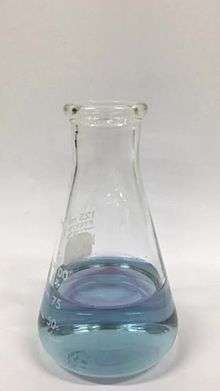Vanishing valentine experiment

The vanishing valentine experiment is a type of chemical reaction related to the blue bottle experiment. This reaction is occurs by mixing water, glucose, sodium hydroxide, and resazurin in the water bottle. When the solution is shaken, it will turn from light blue to redish color and turn back to light blue after leaving still for a while. This reaction can be repeated many times without having to add the solution again.[1]
After mixing all the components, shake the bottle and the color will turn to red or pink depend on the amount of resazurin in the solution. More resazurin will result in more time needed for the solution to turn back the color and the intensity of the red color.
Chemical reaction

Glucose reduce resazurin to resorufin which will then be reduced again to a colorless compound dihydroresorufin. When dihydroresorufin is shaken, it is oxidize back to resorufin because when shook, the oxygen in the bottle will oxidize dihydroresorufin and make it back into resorufin.[2]
- reduced color of the experiment
- oxidized color of the experiment
Pattern formation
Vanishing Valentine pattern formation is the new modification to the original blue bottle experiment which has a similar mechanism.[3] Vanishing Valentine experiment is developed by Steven Engerer and Gilbert Cook which is inspired by Campbell's work from 1963. Later in 1994, Cook made changes to the classic blue bottle experiment in his article called "Blue Bottle Experiment Revisited".[4] The possible application of this experiment is to identify oxygen level of intelligence food packaging and oxygen scavenger for super-resolution imaging.[3] Instead of using methylene blue (blue bottle experiment), Vanishing Valentine uses resazurin that the solution will turn into colorless/fluorescent red.
During the experiment, the solution will be tested on a thin petri dish to be easily observed. With the mixing of sodium hydroxide, glucose and resazurin the color of the solution will turn to be light pink. Then, stir gently until the whole solution turns bright pink. After leaving the solution for a few minutes to oxidized, the bright pink colour will slowly fade into light pink.[5] For a certain time, the patterns will start to develop due to different densities of glucose and the oxidized product.[4] In the beginning of pattern formations, the patterns will start developing with a ring on the edge of the petri dish. Then, numerous dot-like pattern will appear, furthermore these dotted pattern will start to move in spiral or current-like movement. In addition, with more trial of stirring, the solution patterns will be slightly different. In other words, the first trial will acquire the clearest dots-like pattern.[3]
 Pattern formation after stirring
Pattern formation after stirring Pattern formation 1
Pattern formation 1 Pattern formation 2
Pattern formation 2 Pattern formation 3
Pattern formation 3
Additional media
 Vanishing valentine trial 1
Vanishing valentine trial 1 Vanishing valentine trial 2
Vanishing valentine trial 2 Vanishing valentine trial 3
Vanishing valentine trial 3 Vanishing valentine trial 4
Vanishing valentine trial 4
 Vanishing valentine trial 1 speed x8
Vanishing valentine trial 1 speed x8 Vanishing valentine trial 2 speed x8
Vanishing valentine trial 2 speed x8 Vanishing valentine trial 3 speed x8
Vanishing valentine trial 3 speed x8 Vanishing valentine trial 4 speed x8
Vanishing valentine trial 4 speed x8
See also
| Wikimedia Commons has media related to Vanishing valentine experiment. |
References
- ↑ "Vanishing Valentine Chemistry Demonstration". About Education. Retrieved 13 November 2015.
- ↑ "The Vanishing Vaentine" (PDF). Flinnsci. Retrieved 13 November 2015.
- 1 2 3 Rajchakit, Urawadee; Limpanuparb, Taweetham (2016-01-01). "The Blue Bottle Experiment". Thai Journal of Science and Technology (in Thai). 24 (1): 1–11. ISSN 0858-4435.
- 1 2 Limpanuparb, Taweetham; Hsu, Suphattra (2015-04-10). "The Colorful Chemical Bottle Experiment Kit: From School Laboratory To Public Demonstration". arXiv:1504.02604
 .
. - ↑ The Vanishing Valentine (PDF). Batavia, IL: Flint Scientific. 2010. p. 2. Retrieved 11 February 2016.